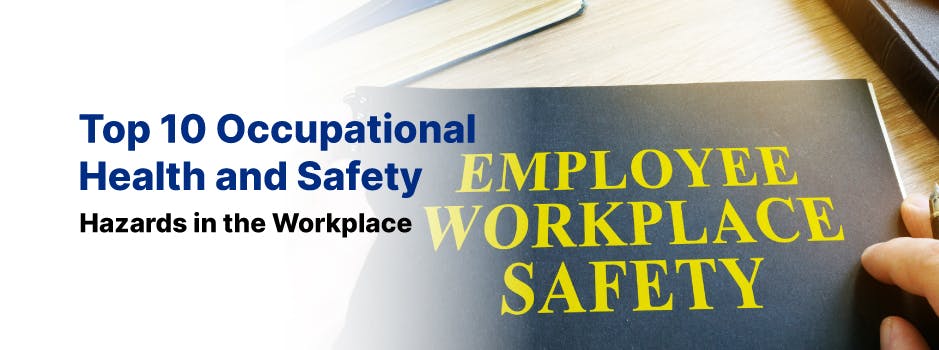Every day, millions of people around the world go to work, often with the sole purpose of making a living and providing for their families. But for some, the workplace can pose serious risks to their health and safety. In fact, occupational hazards are responsible for numerous injuries, illnesses, and even fatalities each year. Identifying and addressing these hazards is crucial to ensuring a safe and healthy work environment. In this blog post, we will discuss the top 10 occupational health and safety hazards in the workplace and provide tips on how to mitigate their impact.
Slips, Trips, and Falls
Slips, trips, and falls are among the most common workplace hazards, resulting in countless injuries and even fatalities. These accidents can be caused by wet floors, uneven surfaces, obstructed walkways, and inadequate lighting. To prevent slips, trips, and falls, employers should implement proper housekeeping, maintain walkways, and install appropriate lighting. Employees can reduce their risk by wearing non-slip footwear, using handrails, and paying attention to their surroundings.
Ergonomic Hazards
Poor ergonomics can lead to musculoskeletal disorders, such as carpal tunnel syndrome, tendonitis, and back pain. Ergonomic hazards are often the result of repetitive motions, awkward postures, and improper workstation setups. To mitigate these risks, employers should provide adjustable workstations, ergonomic equipment, and training on proper body mechanics. Employees can also practice good posture, take regular breaks, and perform stretching exercises throughout the day.
Chemical Hazards
Exposure to hazardous chemicals can cause serious health issues, such as respiratory problems, skin irritations, and even cancer. Chemical hazards can occur in various forms, including gases, vapors, liquids, and solids. Employers should implement a chemical safety program, provide proper ventilation, and use less hazardous substances when possible. Employees should receive training on the safe handling and storage of chemicals, as well as the use of Personal Protective Equipment (PPE).
Biological Hazards
Biological hazards, such as viruses, bacteria, and fungi, can lead to infections, allergies, and other health problems. These hazards are particularly prevalent in healthcare settings, laboratories, and food processing facilities. Employers should establish infection control procedures, provide PPE, and maintain a clean work environment. Employees should follow hygiene practices, such as handwashing and the proper disposal of waste.
Noise Hazards
Exposure to excessive noise can result in hearing loss, stress, and other health problems. Noise hazards are common in industries like construction, manufacturing, and entertainment. Employers should implement engineering controls, such as sound barriers and mufflers, as well as provide hearing protection devices. Employees should participate in hearing conservation programs and limit their exposure to loud noises.
Electrical Hazards
Electrical hazards, such as electrocution, electrical fires, and explosions, can cause severe injuries and fatalities. These risks are common in construction, maintenance, and utility work. Employers should ensure that electrical systems are properly installed and maintained, and employees should receive training on electrical safety. Workers should also use insulated tools, wear protective clothing, and follow lockout/tagout procedures.
Confined Spaces
Confined spaces, such as tanks, silos, and tunnels, can pose significant health and safety risks. Hazards include toxic gases, oxygen deficiency, and engulfment. Employers should establish a confined space entry program, conduct hazard assessments, and provide appropriate PPE. Employees should receive training on confined space safety and follow established entry procedures.
Vehicle Accidents
Vehicle accidents are a leading cause of workplace fatalities, particularly in industries like transportation, construction, and warehousing. Employers should implement vehicle safety programs, enforce safe driving policies, and provide regular vehicle maintenance. Employees should receive training on defensive driving techniques and adhere to traffic regulations. Additionally, workers should always wear seatbelts and avoid distractions while driving, such as using cell phones or eating.
Workplace Violence
Workplace violence can range from verbal threats and harassment to physical assault and homicide. It can occur in any industry but is particularly prevalent in healthcare, retail, and public service settings. Employers should establish a zero-tolerance policy for workplace violence, provide employee training on conflict resolution, and develop emergency response plans. Employees should be encouraged to report incidents of violence or harassment and should familiarize themselves with available resources, such as employee assistance programs.
Fatigue and Stress
Fatigue and stress can lead to decreased productivity, poor decision-making, and increased risk of accidents. Long working hours, high job demands, and a lack of work-life balance can contribute to these issues. Employers should promote a healthy work-life balance, encourage regular breaks, and provide support for stress management. Employees can practice self-care, such as getting adequate sleep, eating well, and engaging in regular physical activity.
Conclusion
Occupational health and safety hazards are present in almost every workplace, but with the right preventive measures, their impact can be significantly reduced. By recognizing and addressing these top 10 hazards, employers can create a safer and healthier work environment for their employees. Additionally, employees should take responsibility for their own safety and well-being by following established safety procedures and engaging in healthy practices both in and out of the workplace. Together, we can work towards reducing the number of workplace accidents, injuries, and illnesses, and ensure that everyone has the opportunity to work in a safe and healthy environment.

